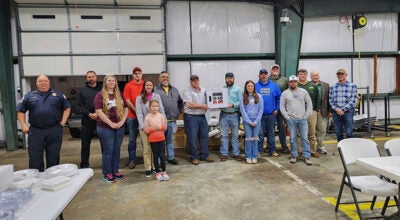Windsor Town Council expresses concerns about Shiloh Drive sidewalk project
Published 1:29 pm Friday, March 4, 2022
|
Getting your Trinity Audio player ready...
|
The Windsor Town Council had a discussion during its Feb. 8 meeting on the state of the Shiloh Drive sidewalk, sharing concerns about the long-term effectiveness of efforts to repair an eroded portion and concerns about whether the original engineering of it was adequate.
Prior to the discussion, Town Manager William Saunders shared a brief update on the project.
“The repairs on the eroded portion of the sidewalk were completed on Feb. 2,” he said. “The repairs included replacement of the saturated soil from the embankment with compacted clay,
which was then armored with matting and riprap stone. A berm was also installed along a
portion of the sidewalk to help funnel stormwater into the yard drain that was installed during
the previous change order repairs.
“And I will mention that the most recent work on the saturated soil area, the eroded portion, was done as part of the change order where that work was completed in May of 2021, so the warranty on that will run through May 5 of 2022.”
Vice Mayor Greg Willis said, “If this problem does not resolve itself — and this problem has been ongoing since that sidewalk was laid there — how can the warranty run out on it, since it has not been legitimately repaired?”
Saunders said the hope is that the sidewalk was legitimately repaired Feb. 2, “but I see what you’re saying.”
He noted that the situation has a lot of moving parts. One part is the question of what is causing the erosion issue in the first place. Another part is the question of how much accuracy or faith there is in how the sidewalk was engineered, and yet another part is the contractor only being bound to follow the plans that he had.
“So it’s easy to put it all on the contractor because he’s the last guy to touch it, but the contractor’s only bound to do what is in the plans,” Saunders said.
He noted that if there are extenuating circumstances — like if there is saturated soil for some reason or if the slope was too steep for the engineering method of construction — that really does not fall back on the contractor.
“This is the second time they’ve rebuilt it, and in an effort to get the contractor to go back and do more of a job there than was done before, VDOT offered to donate the riprap that was put in there,” he said. “The contractor put in his time and some of the materials to make this happen, but abnormal conditions in the soil or issues with the design itself aren’t really things that you can hold the contractor liable for.”
“Who can we hold liable for it?” Willis asked.
“This is a very complicated subject,” Saunders replied.
Willis pointed out that the council has not really gotten an answer to the question of what the cause of the problem is.
“Fixing it’s one thing, but what is the cause?” he asked.
“That is a good question, and that is beyond the scope of this project, unfortunately, to determine,” Saunders said. “If there’s some unknown issue that’s channeling the water in that area, that determination was beyond the scope of this project. If it’s stormwater, then this (repair) should handle it. It is possible that this issue will flare up again, and it is possible that there may have to be a different type of fix there than what was engineered today. We may have to pipe that ditch to get the slope down to a more reasonable angle because that is so steep.
“But it was a county project with county money, and VDOT was partnering with the county, and we put in some cost share funds to go along with it,” he added. “So technically it’s not our project even though we’ll be taking the sidewalk into our system.”
He reiterated that the warranty on the repair work runs until May 5.
“If council is of a mind that that is not acceptable to them, then we can certainly send a letter to the county,” he said. “If you want me to send a letter to the county asking for more warranty or outline any other concerns, I would ask that you take a vote so that we know it’s coming from all of council, and I’ll be glad to pen the letter if that’s council’s desire.”
Willis said it would not be his desire to pin the blame on the contractor if he did what the design called for, and Saunders affirmed that the contractor did, in fact, do what the design called for.
“But was the design not appropriate for the topographical circumstances?” Willis said. “You know what I’m saying? If this is going to be an ongoing (issue), we need to stop putting bandaids on it and find a fix. We’re patching, but we’re not fixing.”
Saunders said, “Given the saturated nature of that soil, I don’t believe that it was engineered properly at the beginning. But the saturated nature of that soil in that area was not a normal expectation at the time.”
Councilman J. Randy Carr said he thinks the contractor has done all he can do and that nature needs to be allowed to take its course, indicating that growth of vegetation will aid in stabilizing the situation.
Saunders said he agreed but noted that if there is possibly a type of spring underground, then this soil could get saturated again at some point.
Carr indicated that given the flatness of the area, the sidewalk probably should have been designed as a raised sidewalk.
Councilman Walter Bernacki asked Town Attorney Fred Taylor about the scenario of the warranty running out in May and the town having additional problems with the sidewalk after that.
“What, if any, liability would fall potentially back on the engineer?” he said. “Because we rely on them, and I would think an engineer, in due diligence, would have looked at grade, looked at soil densities when they’re trying to design this to prevent this type of thing, and how would that play into it so that, like Greg was mentioning, down the road all of a sudden there’s a $50,000 fix that we’ve got to do, and it ends up (being) because of a bad design potential?”
Taylor prefaced his comments by saying he has not reviewed whether a contract existed with the engineer, and he also stated that if the contract is with the county, it would be the county that would have to take the action.
“Obviously, whatever contractually the county engaged in, certainly you can’t contract out negligence and things like that,” he said. “But if there was some determination made that the engineer had been negligent, that would be something they, contractually, could enforce.
“I’ll even go further to say it’s the same way with the warranty,” he continued. “Even with a warranty going out — and I’m speaking very broadly, not specific to this — but even with a warranty going out, if it was a factual problem that existed during the warranty period, that doesn’t just suddenly mean that they don’t have to come fix it if it existed during that time.
“So in June, if we find out, yes, this should have been done a certain way and it wasn’t, that again would be something, not us, but contractually the county would be able to deal with it.”
Later in the discussion, Councilwoman Kelly Blankenship said, “So I guess the question that I still have from all of this dialogue is should we still put in writing our dissatisfaction with the county on this project and the multiple attempts to address it and our concern about the longevity of the current solution, just to get it on record that we’re not thrilled with the project and there are concerns about weather the original engineering of it is adequate?”
Carr said, “I think we should keep a close eye on it and just watch it.”
Mayor Glyn T. Willis helped sum up the issue and the approach the council would take at the time.
“An engineering spec was done,” he said. “That was built. Some changes were made in that specification. The contractor seems to have come in and done what I’ll characterize as almost a little bit beyond what was originally designed. So the contractor seems to be in the right place on this. It goes back to the original engineering design on it and whether or not somebody should have taken into account, ‘Oh, we’ve got this much water coming off of that field, and here’s how it flows.’”
He concluded the discussion by echoing Carr’s advice with regard to the state of the sidewalk: “Let’s see what happens, and we can make a decision. If we’re seeing concerns in March, then we can be a little more attentive to it, but we’ve got a little bit of time, but let’s watch and see.”




